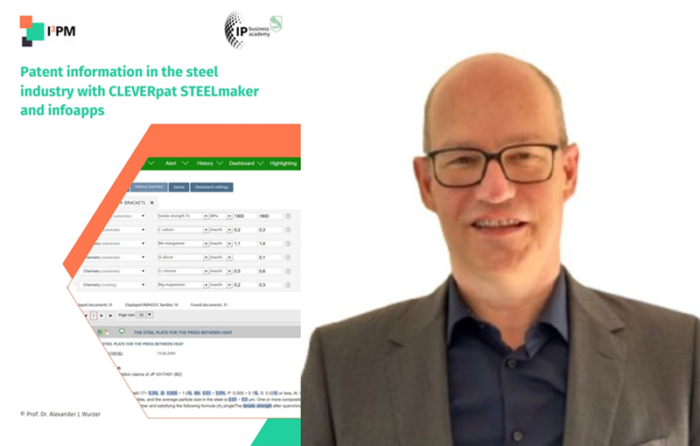Driving Innovation in Steel: How to Use Patent Intelligence for a Competitive Edge
The global steel industry, a foundational pillar of economic development and infrastructure worldwide, is currently undergoing a period of profound and multifaceted transformation. It is far from a static commodity market, profoundly impacted by shifts in geopolitics, rapid technological advancements, and evolving customer demands. In this dynamic environment, the ability to innovate, adapt, and strategically leverage intellectual property (IP) has become more critical than ever. Yet, unlocking the strategic insights embedded within patent information has historically been a complex endeavor, often limited to specialized IP professionals. The case study “patent information in the steel industry” explores the evolving landscape of the steel industry, the critical role of patent intelligence within it, and how the STEELmaker software is revolutionizing access to this vital information, providing steelmakers with an indispensable tool for competitive advantage.
The Modern Steel Industry’s Evolving Landscape and IP Imperatives
The steel industry is grappling with a fundamental tension between long-established globalization and a burgeoning trend towards regionalization. For decades, global trade and integrated supply chains defined the steel landscape, allowing for economies of scale and access to diverse markets. However, recent geopolitical developments, protectionist policies, and vulnerabilities exposed by global crises have spurred a re-emphasis on localized production and more resilient regional networks. This push for regional self-sufficiency, while potentially increasing production costs, prioritizes supply chain resilience and reduced geopolitical risk. The resulting dynamic demands that global players balance their traditional advantages with the need to adapt to regional demands and regulatory frameworks, likely leading to a hybrid model where strategic global partnerships coexist with strengthened regional manufacturing ecosystems.
Simultaneously, the industry is witnessing a pronounced shift towards the individualization of steel products. The era of mass-produced, standardized steel is rapidly yielding to a burgeoning demand for highly specialized materials precisely engineered for specific, often demanding, applications. Key drivers include the automotive industry’s push for lightweight, high-strength steels for electric vehicles, and the aerospace sector’s need for alloys that can withstand extreme temperatures and pressures. The energy sector requires specialized steel for pipelines and renewable energy infrastructure, while construction increasingly seeks customized solutions like high-strength rebar for earthquake-resistant structures or aesthetic stainless steel for architectural facades. This individualization necessitates a fundamental transformation in steelmaking, shifting from volume-centric production to agile, flexible manufacturing systems capable of producing smaller, customized batches. This requires significant investment in advanced research and development (R&D) to create new alloys, refine thermomechanical processes, and develop sophisticated coating technologies.
Finally, digitalization is fundamentally reshaping the steel industry, transforming it from a traditional, analog sector into one that is increasingly data-driven and smart. This extends beyond optimizing production lines through Industry 4.0 technologies like the Internet of Things (IoT) and Artificial Intelligence (AI) for predictive maintenance and process optimization. Crucially, digitalization empowers steel companies to systematically collect, analyze, and interpret external competitive intelligence. This includes monitoring news feeds, industry reports, and, most importantly, patent databases. Unlike fragmented, reactive manual processes of the past, digital tools, often powered by AI, enable proactive and continuous competitive intelligence. This provides unprecedented visibility into the competitive landscape, allowing companies to track competitor R&D, identify market opportunities and threats, and benchmark performance.
In this multifaceted environment, patent intelligence has evolved from a niche legal function into an indispensable strategic asset. Patents, being public disclosures of new inventions, offer a unique window into cutting-edge R&D activities globally. The systematic collection, analysis, and interpretation of this data inform and guide strategic decision-making, enabling companies to identify emerging technologies, pinpoint key innovators, assess competitor IP portfolios, and detect potential infringement risks. This proactive approach helps businesses allocate R&D resources effectively, avoid costly reinvention, identify white spots for novel innovation, and develop robust IP strategies to safeguard their own inventions.
Navigating the Patent Maze: Challenges and Solutions
The steel industry faces distinct and complex challenges when it comes to patent intelligence, primarily stemming from intense international competition and the unique demands of specialty steel product development, which inherently carry heightened risks of patent infringement. Traditional methods often fall short in providing the precision required to navigate this intricate landscape effectively.
International competition in steel is fierce, driven by global overcapacity and aggressive market strategies. To maintain an edge, continuous innovation and a deep understanding of rivals’ strategic moves are paramount. Patent data offers a real-time map of global technological advancements, allowing steel companies to identify new material compositions or processing techniques being developed by competitors worldwide. This enables R&D departments to avoid redundant research, focusing efforts on genuinely novel areas or on improving existing alloys where competitors are less active. For instance, if a competitor patents a novel high-strength steel, an alert steelmaker can quickly identify this, assess its implications, and decide whether to license the technology, develop a workaround, or accelerate their own R&D. This early warning system is vital in a capital-intensive industry where R&D cycles are long and costly. Moreover, patent intelligence facilitates strategic competitive benchmarking, allowing companies to analyze rivals’ IP portfolios to understand their technological strengths, areas of focus, and even their geographical expansion strategies, revealing technological gaps or white spots to exploit.
The individualization of steel products, particularly the growth of specialty steels, introduces a heightened layer of complexity and risk, especially concerning patent infringement. Specialty steels are custom-engineered alloys with precise chemical compositions and mechanical properties tailored for demanding applications. The subtle differences in alloying elements and their proportions, often defined by very narrow ranges in patent claims, can define a new, patentable steel grade. This creates significant infringement risks because when developing a new specialty steel, there’s a high probability that certain elemental compositions or material performance characteristics might inadvertently overlap with existing patents. Identifying these potential overlaps using traditional patent search methods is incredibly challenging. Patent claims for steel alloys often specify minute ranges of chemical elements, down to fractional percentages, or define complex relationships between multiple elements. A manual review of thousands of patents for these intricate details is time-consuming, prone to error, and requires highly specialized expertise. An accidental infringement can lead to costly litigation, injunctions, significant financial damages, and severe reputational damage.
This is precisely where modern patent information software, such as the STEELmaker tool presented in the case study, offers a strategic and transformative response.
First, regarding international competition, such tools provide a comprehensive global full-text search capability, including machine translations. This ensures that steel companies have access to patent information from virtually every major steel-producing region and country, eliminating geographical blind spots and offering a truly global overview of technological advancements and competitive activities. By making these diverse global patent landscapes searchable and understandable, they empower companies to proactively monitor their international rivals, identify emerging technologies, and adapt their strategies accordingly.
Second, and most critically, they directly tackle the challenges of specialty steels and infringement risks through a unique and highly precise search functionality for chemical compositions and material properties. This enables users to search for chemical elements and their exact proportions, including value ranges – a paramount feature for specialty steels where slight variations in elemental composition define novelty. Researchers can specify complex alloy formulations and identify patents claiming similar compositions, allowing them to fine-tune their own innovations to avoid infringement. Furthermore, they allow for differentiation between chemical elements in the substrate and surface coating, a critical feature for developing and protecting innovations in advanced coated steels. They can also harmonize units automatically, ensuring that searches for mechanical properties like tensile strength or yield strength are consistent and accurate, regardless of how they are expressed in different patent documents. By providing these granular, industry-specific search capabilities, such patent search tools allow steel companies to conduct highly accurate and efficient Freedom-to-Operate (FTO) analyses for new specialty steel products, dramatically reducing the risk of inadvertent patent infringement.
Democratizing Patent Intelligence and Cultivating a Proactive IP Culture
Making patent intelligence genuinely accessible is paramount for steel companies seeking to harness the full strategic value of their intellectual property. Historically, patent databases have been complex, fragmented, and largely unintelligible to anyone outside the specialized realm of patent law. This created a significant barrier, isolating valuable insights within IP departments and preventing R&D teams, engineers, and business strategists from directly leveraging patent information to inform their daily work. Tools such as the STEELmaker fundamentally transform this landscape, democratizing access to patent intelligence through innovative approaches.
One key aspect of how to achieve accessibility is by translating technical jargon into actionable insights. Traditional patent documents are notoriously dense, filled with legalistic language, and complex classification codes that can be overwhelming for a metallurgist or an engineer whose primary expertise lies in material properties, not legal claims. Modern tools bridge this gap by offering search functionalities that speak the language of steel, rather than strictly legal or broad patent terms. For instance, an engineer can directly input specific alloy compositions using familiar chemical symbols and ranges, or search for desired mechanical properties like “tensile strength over 800 MPa,” without needing to translate these into abstract keywords or patent classes. This intuitive input mechanism dramatically lowers the cognitive load and expertise required, making the system feel like an extension of their daily technical tools, not a foreign legal database.
Furthermore, search tools enhance accessibility through their focus on visual data representation and streamlined reporting. Raw patent data, presented in long lists, can be incredibly difficult to interpret and extract meaningful trends from. Modern tools highlight the important parts of patent documents and transforms complex search results into easily digestible formats. This allows non-experts to quickly grasp the big picture — identifying crowded technology areas, pinpointing white spots for innovation, or visualizing the competitive landscape at a glance. Such visual cues significantly improve comprehension and facilitate quicker decision-making among technical and business teams.
Another crucial contribution of such software solutions is the integrability into existing R&D workflows, which fosters proactive IP awareness. Instead of patent searches being a standalone, often reactive, task performed only when a patent application is formally considered, they encourage continuous engagement with patent data. By being user-friendly enough for daily use, they enable engineers to conduct quick preliminary searches as they ideate and develop new concepts. This shifts intellectual property considerations from an afterthought to an integral part of the innovation process. For example, a researcher exploring a new coating for corrosion resistance can perform a rapid search on similar existing patents before significant R&D investment, guiding their experimental design away from patented territory and towards truly novel solutions. This embedded IP mindfulness throughout the research lifecycle significantly reduces the risk of costly dead ends and potential litigation, while simultaneously cultivating a culture of innovation that is inherently aware of the broader IP landscape.
Finally, smart tools contribute to accessibility by facilitating seamless collaboration between IP experts and technical teams. While they empower non-experts with direct access to information, it does not diminish the role of IP professionals. Instead, it transforms it. IP departments can leverage them to curate and disseminate highly relevant patent information to specific R&D teams, monitor competitive portfolios, and perform in-depth analyses that are then easily shared and understood by their technical counterparts. Such platforms can serve as a common ground where IP and technical insights converge, enabling richer discussions, faster decision-making, and a more unified, strategic approach to innovation across the entire organization. This collaborative ecosystem ensures that patent intelligence is not just accessible data, but a shared organizational asset that fuels collective progress and maintains a competitive edge.
Conclusion: Lessons for the Future of Steel IP Management
The journey of the steel industry through global shifts, product individualization, and digital transformation underscores the undeniable need for sophisticated IP management. The experience with intelligent patent search tools, such as the STEELmaker, offers profound lessons for any company seeking to thrive in this complex environment.
A primary takeaway is the absolute criticality of precision in material science patent searches. Generic tools simply fall short when dealing with the nuanced chemical compositions and material property ranges inherent to steel patents. The ability to search for exact value ranges for elements, differentiate between substrate and coating, and harmonize units has proven indispensable. This capability significantly reduces misdevelopments and ensures comprehensive prior art discovery, directly impacting a company’s ability to innovate confidently and avoid costly legal disputes.
Another key lesson is the immense value derived from democratizing patent data. By offering an intuitive interface tailored specifically to engineers and R&D professionals, patent tools empower non-IP experts to directly engage with patent information. This fundamentally shifts the IP department from a reactive service provider to a proactive, strategic partner, fostering IP awareness throughout the entire innovation lifecycle. This accessibility accelerates R&D cycles, minimizes redundant work, and seamlessly embeds IP considerations in the earliest stages of product development, ensuring that innovation is both robust and legally sound.
Finally, the case study highlights the undeniable necessity of global, comprehensive coverage within patent searching tools. A worldwide full-text search capability, including high-quality machine translations, ensures that companies have a complete, unfettered view of the international steel patent landscape. Coupled with a structured workflow that streamlines collaboration between IP and technical teams, user-friendly patent intelligence is far more than just an efficiency tool; it is a fundamental driver for competitive advantage and confident innovation within the fiercely competitive and complex steel industry.
About the author:
 As a mechanical engineer, Sascha Kamhuber is working in the patent field since 2006 as CEO of infoapps GmbH. His focus was always to make patent information available, not only for the patent experts, but especially for engineers and researchers in companies. Therefore, he is designing patent tools, which have a high degree of intuitive operability. Also, his solutions are focusing on the needs of specific industries, such as the steel industry.
As a mechanical engineer, Sascha Kamhuber is working in the patent field since 2006 as CEO of infoapps GmbH. His focus was always to make patent information available, not only for the patent experts, but especially for engineers and researchers in companies. Therefore, he is designing patent tools, which have a high degree of intuitive operability. Also, his solutions are focusing on the needs of specific industries, such as the steel industry.



